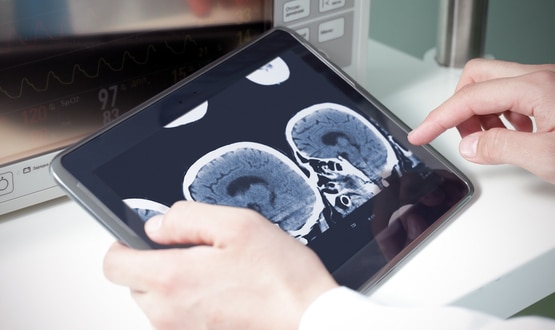Mitigating a post-covid-19 surge on imaging departments with joined tech
- 7 July 2020

Despite a falling number of Covid–19 patients in ITU, imaging departments are facing another surge in demand, explains Dr James Diss, radiology registrar at Princess Alexandra Hospital (PAH) NHS Trust. He explains how tech will be vital in helping them continue to provide high-quality care.
With only one COVID-19 patient in ITU following the first peak of the COVID-19 pandemic, you might think things are quieter at PAH, but you would be mistaken. Imaging is facing another surge in demand, well in advance of a second wave that many are anticipating.
Since the beginning of the outbreak, people without COVID-19 have been keeping away from hospitals, which reduced the number of imaging tests we had to carry out. But as infection rates continue to fall, an influx of people are beginning to return to the hospital because they now feel that it is safe enough to be reviewed and treated.
At the same time, we need to resume the imaging backlog that built up as we dealt with the coronavirus, we have former COVID-19 patients who will need further imaging as part of their recovery, and we also have our normal workload.
All of this means that we are preparing ourselves for a second surge in demand. However, having seen the value of technology during the first wave of COVID-19, we feel prepared for it.
Using tech to meet demand
The national rollout of Microsoft Teams was a significant first step in helping the trust recognise how technology can help meet the immediate demands from the Coronavirus.
Microsoft Teams was rolled out to all users of NHSmail in England and Scotland in March to quickly facilitate remote working and consultation during the COVID-19 outbreak, and it provided us with the data sharing and chat functionality that colleagues had been requesting for months.
But while the new functionality promised to provide a new, fast and secure line of communication, we still needed to find a way to make it work in practice. And as we were already using Agfa’s XERO Image Viewer for radiology, we thought the best way to do this was by speaking with the two technology companies to see if we could integrate their systems.
After just a few weeks of development, we are the very first in the organisation to have this new combined system in place, which helps free up the time we need to cope with the demand.
From a security point of view, the integration aligns to information governance policies, and everything is fully-auditable so that we can use it to support enhanced image sharing between clinicians, with user-specific access rights and controls. As a result, colleagues can seamlessly and securely share COVID-19-related images via their mobile device; they simply click on a button within the Image Viewer and use the chat functionality within Teams to discuss what they see.
Normally, sharing and discussing images would take a significant amount of time — two people would have to log in to a computer simultaneously, share patient details, and debate their findings, and often these computers take several minutes just to boot up. Image sharing between staff now takes milliseconds, and it can be done from anywhere in the hospital.
Hospital-wide benefits
These time-saving benefits — reducing many tasks to seconds down — are wide-ranging, especially when access to a radiologist can be a challenge.
For example, the integration is especially useful at night when there might not be a radiologist on-site. Now, staff can more quickly share images and get advice from senior members of staff without a radiologist’s input.
Likewise, it benefits junior doctors who are still learning and often need to seek senior input or might want to ask the radiology team for advice. They can get a response from a senior member of staff within seconds of reviewing the images, and without either of them having to log in to a computer.
The same can be said for senior house officers (SHOs), who might also need senior input on a diagnosis. For example, they may be unsure whether a patient has a fracture and if they can’t find a registrar to review the image, they may err on the side of caution and ask for an additional CT scan. Now, because they can share images and collaborate with colleagues in real-time, they won’t need the scan, which in turn, reduces the burden on the radiology team.
With this technology, we are providing clinicians with a much more efficient workflow process where they don’t have to take down details, login to computers, request unnecessary tests, or chase people.
However, the benefits aren’t just for our internal colleagues. Our imaging strategy involves linking in with other Trusts. Even if they use a different Picture Archiving Communication System (PACS), we can supply them with access to XERO Viewer and Teams, and they can view relevant images. We are already doing this with our vascular team, whose imaging is being carried out off-site.
Embracing innovation
We feel what is happening here is significant, even though we are still in the early stages of adoption. Staff usage and interest in the technology is growing, which is a really positive sign. And our critical care team, and specialist departments such as cardiology, theatres and ophthalmology, are all keen to know more.
One of the few positives to come out of the pandemic is the enthusiasm from staff for innovation; we have achieved more in the past couple of months than we have done in the last five years. Staff have seen the benefits that technology can provide in improving productivity and collaboration amongst teams, and most importantly, clinical care and patient outcomes.
We are all living and working in challenging times, but I’m delighted to have been part of a positive consequence that resulted in a significant improvement to the way we collaborate as clinicians and care for our patients.




